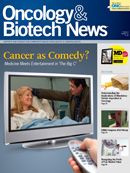Publication
Article
Oncology & Biotech News
Cancer as Comedy? Medicine Meets Entertainment in 'The Big C'
Author(s):
The ambitious effort to portray the cancer journey of one fictional patient marks an intersection of medicine and entertainment that has attracted widespread attention
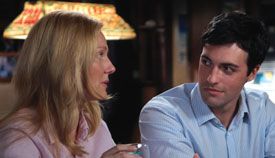
The opening song for the new Showtime series, The Big C, asks, “Is this some kind of a joke?” No one associated with the show thinks cancer is funny. But they do think a dark, comedic treatment about a patient with cancer has something to say about how we react to the disease.
Like many Americans, actor Reid Scott knows what it feels like when a loved one fights a losing battle against cancer. He was a teenager when his grandfather died of mesothelioma, and he was a young actor living in New York City when a college friend succumbed to the disease after a lifelong struggle.
Those ordeals are among the “back stories” that Scott says helped him internalize his role as television’s most visible oncologist this season. Scott plays the boyish Dr Todd in The Big C, Showtime’s dark comedy about a stage IV melanoma patient.
Scott knows that cancer is no laughing matter, but he feels the show’s boundary-pushing personas allows for a fuller exploration of the cancer experience.
“So many times—and I [completely] understand why—this sort of subject matter is addressed purely as a tragedy or purely as a drama. For lack of a better term, they sort of construct them as tear-jerkers,” Scott said in a recent interview with Oncology & Biotech News. “I don’t think that’s necessarily the entire experience. I know from personal experience, when my grandfather was battling and when my friend, Mark, was battling, we laughed a lot. We didn’t necessarily poke fun at the situation, but you have to find some humor.
“So I think in a strange way, having a show that deals with cancer in the context of a dark comedy—I think that’s almost more human than just approaching it as a straight-up drama or straight-up tragedy,” he said.
That view of the cancer experience is striking a chord. The ambitious effort to portray the cancer journey of one fictional patient marks an intersection of medicine and entertainment that has attracted widespread attention from oncology healthcare professionals, cancer survivors, and audiences.
More than 6.5 million people watched the mid- August premiere episode across various platforms, and Showtime officials announced in September that the series has been renewed for 2011. If produced as planned, the story will unfold over 6 television seasons, depicting 18 months of the main character’s life in segments that coincide with seasons on the calendar.
Laura Linney, a three-time Academy Award— nominee, heads the cast as Cathy Jamison, a suburban schoolteacher in her early 40s who dramatically changes the way she lives her life when she learns she has cancer. She goes from being a reserved wife and mother who prizes a well-kept house and cringes when her son curses to someone who rips up her front lawn to install a swimming pool and pushes the envelope in new relationships—including the increasingly personal one with her physician.
“For me, the show is all about time and what time we have and how we choose to use it,” Linney said in an interview with Showtime. “Equally important to me is looking at the privilege of aging. I hear so many people complaining about getting old; being shamed about the age on their face, not wanting to live a period of time in their life, wanting to move back in time. And, you know, aging is a tremendous privilege. I hope the show really explores that message because we’re very lucky to move into the different phases of our life.”
“People come up to me and say, ‘How are you going to do a comedy about cancer?!’...It’s not really a comedy about cancer,” she said. “It’s a comedy about a woman who has cancer and there’s a big difference. When anyone is dealing with change or a huge challenge, life has a way of not allowing you to be too serious about it.”
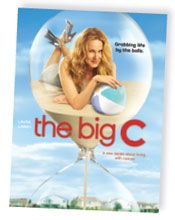
Media Portrayals Affect Public Perceptions
Considering the number of people expected to be grappling with cancer in the coming decade, millions of Americans will likely face life challenges similar to those facing the characters in The Big C.
The number of cancer survivors, defined as cancer patients from time of diagnosis until death, is estimated to be more than 11 million people today, and it is expected to hit 20 million by 2020, according to the American Cancer Society (ACS).
Meanwhile, the incidence of melanoma continues to rise, with about 68,130 new diagnoses estimated for 2010, the ACS says. While 5-year survival rates for melanoma are >90% in the earliest stages, the 5-year survival rate drops to 15% to 20% for those with stage IV diagnoses.
With celebrities leading the way, cancer patients are increasing willing to share their stories, in many cases serving as ambassadors for nonprofit organizations.
The Big C “seems like yet another place that a discourse is being raised about what the experience of cancer is, and how there is no standard cancer patient and how much pressure there is on people with cancer to be ‘just fine,’” said Susan E. Bell, PhD, MA, a medical sociologist who teaches at Bowdoin College, Brunswick, Maine. “It’s yet another example of an explosion of discussion about cancer and [the] connection among people with cancer that has been occurring since about the 1970s.”
The impact that media portrayals of cancer have on the public is well established and one reason why the National Cancer Institute launched the Entertainment Education Program in 2003 to provide writers and producers with accurate information about various cancer topics. The NCI noted that “television shows, movies, and music not only command the attention of their audiences, but also reinforce existing behavior, demonstrate new behavior, and affect audience emotions.”
Elizabeth Edsall Kromm, PhD, MSc, an adjunct assistant professor at the Johns Hopkins Bloomberg School of Public Health, Baltimore, Maryland, has examined the manner in which cancer survivors have been portrayed in news stories. Kromm and colleagues analyzed 89 articles that appeared in 15 leading daily newspapers (J Cancer Surviv. 2007;1:298-305).
“The media have been able to talk about [cancer] and really reduce the stigma associated with cancer and a cancer diagnosis,” Kromm said. “But I do think that what tends to happen is that it is often an idealized portrayal of the experience. We saw evidence of this in our study, and other researchers have identified similar framing.”
Kromm said the quotes by survivors that end up in print frequently convey that “while cancer is a terrible thing, it actually ended up being a life-changing event, and the best thing that could have ever happened to me, and it gave me focus.”
“It could be that the majority of cancer survivors end up getting to a point where they would agree with the statement that they are in some ways thankful and grateful for having lived through the experience, but there could also be negative implications for this to be our society’s primary working definition of what it means to be a survivor. For example, if you are not out there volunteering and telling your story from the moment you’re diagnosed, a limited scope of public understanding could interpret these actions as not living up to the title of cancer survivor,” Kromm said.
Kromm has firsthand experience with such expectations. She was 3 years old in 1981 when she was diagnosed with Wilms tumor, a cancer of the kidney that strikes children. She was treated for about 5 years and has been cancer-free ever since. She became one of the inspirational cancer stories she ended up studying. Reflecting on her own experience, she acknowledges that she and her family fully engaged with the traditional model of survivorship—volunteering at the hospital, helping with telethons, and doing events with their local ACS chapter.
As an adult, Kromm now sees the humor in her own cancer journey. “I do know that my mom adopted a very liberal ‘anything goes’ policy when I was in the thick of treatment. When I lost all of my hair, she went out and found these very elaborate headbands and hats and ribbons. Anything I wanted to wear, regardless of how badly it clashed—or whether someone might think, ‘Why would she let her child go out looking like that?’—was fine with her. I think she just thought that the other stuff didn’t matter in comparison to what we were dealing with at the time.”
Character Departs From Expected Behavior
Linney’s character in The Big C departs from the stereotype of a patient with cancer who becomes everyone’s inspiration. She is repelled in comic fashion by overly earnest members of a cancer support group, separates from her husband, initially decides to forgo treatment, and hides her illness from her family much of the first season.
Timothy Turnham, PhD, executive director of the Melanoma Research Foundation, Washington, DC, said the character resonates with melanoma patients even though her behavior is not typical and is often not realistic.
“Do most cancer patients start using drugs, having affairs, or spend their retirement savings on fast cars after a diagnosis? Probably not,” he said in an interview.
"Having a show that deals with cancer in the context of a dark comedy—I think that’s almost more human than just approaching it as a straight-up drama or straight-up tragedy." —Reid Scott
“But Cathy’s response is a beautiful and humorous portrayal of a woman grappling with her mortality, the impact her absence will have on her family, and learning how to enjoy life to its utmost and be true to herself,” he said. “It’s poignant and reflects the struggles that most melanoma patients encounter. We work with cancer patients who express a strong desire to ‘seize the day’ and make the most of whatever time they have left.”
Jenny Bicks, an executive producer and writer on The Big C, said the series walks a “fine line” in painting a cancer patient in a comedic light.
“Even when you get absurd in this kind of storytelling, I think there has to always be underneath it a sense of truth...The thing that Laura does so well is she always is aware she’s the actress, always aware of her mortality running underneath everything. So even when you’re playing that comedic scene, that character and that actress is aware that she’s dying, and I think that brings a gravitas and a truth to it.”
Bicks, who was treated for early-stage breast cancer about 10 years ago, has clear memories of her own cancer journey.
“I don’t think there is such a thing as a typical [cancer] journey, and I think the most important thing that we could put out there, quite honestly, is to have empathy for people going through cancer and to understand that each person is going to respond differently, that they may not do things the way you think you would do them or you think they should do them,” Bicks said.
“The thing that I know to be true is it’s very hard to tell people,” she said. “Every time you tell them, you have to deal with their reactions, and that’s really emotionally taxing and hard.”
Bicks remembers vividly the moment she learned that she had cancer.
“I don’t think anyone forgets the moment that somebody says, ‘It’s cancer,’” she said. “And for me it was so bizarre. Because I was young, my surgeon had been convinced that it was probably a cyst… It was doubly surprising when he said the words. And I remember what I said to him. My first response was, ‘Are you kidding?’ Then I thought, ‘Who would play a joke like that? Why would a cancer surgeon think that was funny?’”
“You literally leave your body,” Bicks said. “You go into shock. And it took a long time...for me to accept what I was going through.”
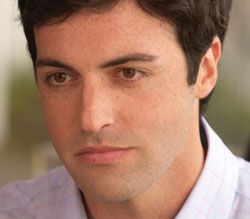
How Survivors View the Show
Turnham said melanoma patients have expressed a variety of reactions to the series, including frustration about the way certain medical details have been portrayed. For example, the show’s creators describe Dr Todd as an oncologist, but Turnham said that he and others view Dr Todd as a dermatologist treating a cancer patient.
In addition, Turnham said few melanoma patients decide not to pursue any treatment— most are aggressive in learning about clinical trials and other options—and they “almost always” seek the support of family and friends.
At the same time, Turnham said patients enjoy watching the show because they can relate to the urge to do things that they normally would not do and to find humor in their situation.
Andrea Heitker, a 39-year-old melanoma survivor who lives in Cincinnati, Ohio, said she is excited about the show even though her cancer experience has been far different from the show’s character. She reached out to her husband immediately after learning of her stage III diagnosis last year and underwent 2 surgeries and a year of interferon treatment. The prognosis for a recurrence is about 30%, she said.
In May, Heitker started a blog, Melanoma Girl, and she is raising money to promote awareness of the disease. Her slogan is “Proud to Be Pale!”
“I actually sent to Laura Linney one of my T-shirts,” Heitker said. “I sent her my signature SPF—Sexy Pale Female.”
Others find a closer match, such as one viewer who posted this comment on the show’s Internet message board after its debut:
“I, too, am a melanoma mom, with a single teenage son, and formerly a teacher, about the same age as LL’s character. I have also made the decision not to pursue chemo due to side effects and limited benefit. Melanoma is very resistant. I feel like they’ve lifted the storyline right from my life!”
What Some Oncologists Think
By contrast, oncologists might not feel that the portrayal of the doctor-patient relationship in The Big C is lifted from their professional experiences. In the show, Dr Todd has lunch with Cathy; in one scene, they dance together; and she accompanies him on a house-hunting trip in another episode.
Vijay Trisal, MD, FACS, a surgical oncologist at City of Hope cancer center in Duarte, California, served as a consultant on certain medical aspects of the show. Trisal, who fulfilled a similar role with the Grey’s Anatomy television series, said in an interview with Oncology & Biotech News that his goal is to help such shows be as medically accurate as possible.
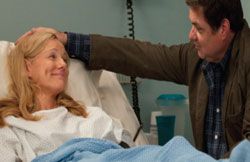
“Whenever I used to see these medical shows, it would make me in one sense a little angry,” he said. “Now, clearly you are in the drama field. You are not in the field of healthcare education. But at the same time this is a very strong attraction for most people to get their information from, and I would not like it if it was totally over the top.”
Although Trisal weighed in on the series, he does not approve of the way The Big C depicts the doctor-patient relationship, particularly some personal comments Dr Todd makes to his patient in an early episode.
“That flippant kind of behavior was not—it’s not normal,” said Trisal, noting a real-life doctor would be distracted by such banter. “Instead of focusing on the patient’s problem and disease, you’re focusing on the personal aspects.”
Similarly, Adam I. Riker, MD, FACS, a surgical oncologist who treats patients with breast cancer and with melanoma at the Ochsner Lieselotte Tansey Breast Center, Ochsner Health System, New Orleans, Louisiana, said the relationship between the two characters “is not the norm.”
At the same time, he said oncologists do spend time talking with their patients, as the show illustrates. “This is somebody’s life you’re dealing with, and you’ve got to spend the time with them to discuss clinical trials, to discuss treatment options,” said Riker, who is a member of the Oncology & Biotech News advisory board. “This is a pretty intense discussion.”
Actor Scott said he thought about the doctorpatient relationship when he approached his role. Cathy is Dr Todd’s first patient and the physiciancharacter “has not been jaded yet,” Scott said.
“He still believes, and maybe rightfully so, that he can make a huge impact on his patients’ lives in all aspects,” Scott said. “He maybe hasn’t garnered the skill yet of separating himself emotionally from his patients, and I think that comes from his earnestness, his eagerness to be a good doctor. He’s a real genuine guy and he genuinely cares, maybe even too much.
“I think he feels, ‘Here’s someone who is my charge, is in my care. If I want to help this person, maybe the help I can give extends beyond just here in the exam room.’ Maybe that pushes a boundary ethically...I’m always curious as to what real doctors say about that. But again, [as] he’s approaching it, it’s not seamy or seedy from his point of view. He’s doing it because he genuinely cares and wants to help.”
When it comes to helping patients with cancer, some healthcare professionals believe the series will fill an educational role.
“I think one of the big take-home messages is that melanoma will kill you if unrecognized,” Riker said. “So we need to change our behaviors, in terms of how we view tanning and going out into the sun and getting too much sun and sunburns, not wearing sunblock, not seeing your dermatologist for full-body skin exams. All of those things are really important.
“So I think somebody watching the show is going to say, ‘Gee, she’s got melanoma and she’s going to die from her melanoma,’” he said.
